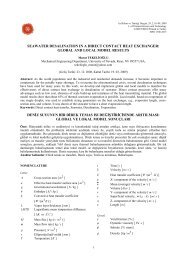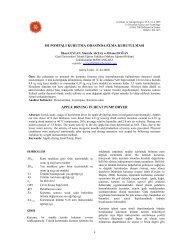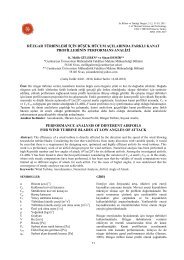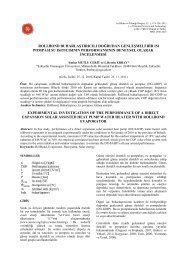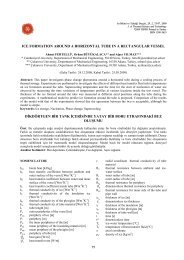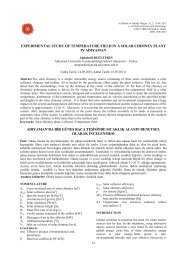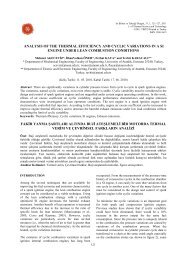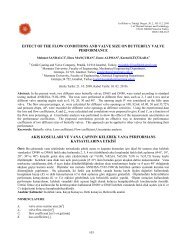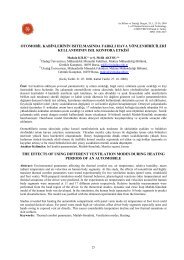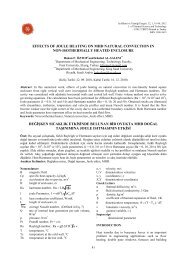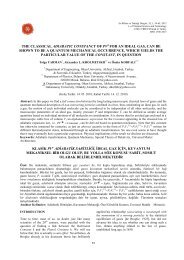modelling of an automotive air conditioning system using anfis
modelling of an automotive air conditioning system using anfis
modelling of an automotive air conditioning system using anfis
You also want an ePaper? Increase the reach of your titles
YUMPU automatically turns print PDFs into web optimized ePapers that Google loves.
Q<br />
evap<br />
m r <br />
(2)<br />
h 7 h 6<br />
With the assumption <strong>of</strong> adiabatic compressor, the power<br />
absorbed by the refriger<strong>an</strong>t in the compressor c<strong>an</strong> be<br />
calculated from<br />
W m<br />
( h 1 ) 2 h<br />
(3)<br />
comp<br />
r<br />
The energetic perform<strong>an</strong>ce <strong>of</strong> the AAC <strong>system</strong> c<strong>an</strong> be<br />
found by evaluating its coefficient <strong>of</strong> perform<strong>an</strong>ce,<br />
which is the ratio <strong>of</strong> the cooling capacity to the<br />
compressor power, i.e.<br />
COP Q <br />
evap W <br />
(4)<br />
comp<br />
The exergy destruction in the adiabatic compressor,<br />
which is due to gas friction, mech<strong>an</strong>ical friction <strong>of</strong> the<br />
moving parts <strong>an</strong>d internal heat tr<strong>an</strong>sfer, c<strong>an</strong> be<br />
determined from<br />
E m<br />
T ( s 1 )<br />
(5)<br />
d, comp r 0 2 s<br />
where T is the environmental temperature representing<br />
0<br />
the dead state.<br />
The rate <strong>of</strong> exergy destruction in the condenser <strong>an</strong>d<br />
liquid line, which is mainly due to the heat tr<strong>an</strong>sfer<br />
originating from the temperature difference between the<br />
<strong>air</strong> <strong>an</strong>d refriger<strong>an</strong>t streams, c<strong>an</strong> be obtained from<br />
h <br />
<br />
<br />
5 h<br />
d, cond m<br />
rT<br />
s s <br />
<br />
(6)<br />
0 5 3<br />
<br />
TE<br />
<br />
E<br />
3<br />
With the assumption <strong>of</strong> adiabatic exp<strong>an</strong>sion, the exergy<br />
destruction in the exp<strong>an</strong>sion valve, which is due to the<br />
refriger<strong>an</strong>t friction accomp<strong>an</strong>ying the exp<strong>an</strong>sion across<br />
the valve, c<strong>an</strong> be evaluated from<br />
E m<br />
T ( s 5)<br />
(7)<br />
d, valve r 0 6 s<br />
The rate <strong>of</strong> exergy destruction in the evaporator, which<br />
mainly stems from the temperature difference between<br />
the refriger<strong>an</strong>t <strong>an</strong>d <strong>air</strong> streams, c<strong>an</strong> be determined from<br />
<br />
<br />
h<br />
h <br />
E 7 6<br />
d, evap m<br />
rT0<br />
s7<br />
s6<br />
(8)<br />
<br />
TB<br />
Finally, the total rate <strong>of</strong> exergy destruction in the<br />
refrigeration circuit <strong>of</strong> the <strong>system</strong> c<strong>an</strong> be found by<br />
summing up the individual destructions, i.e.<br />
<br />
<br />
(9)<br />
E d,<br />
tot Ed,<br />
comp Ed,<br />
cond Ed,<br />
valve Ed,<br />
evap<br />
MODELLING OF THE EXPERIMENTAL AAC<br />
SYSTEM WITH ANFIS<br />
In order to develop <strong>an</strong> ANFIS model for the<br />
experimental AAC <strong>system</strong>, the available data set, which<br />
consists <strong>of</strong> 70 input vectors <strong>an</strong>d their corresponding<br />
output vectors from the experimental work, was divided<br />
into training <strong>an</strong>d test sets. While 50 vectors <strong>of</strong> the data<br />
set were r<strong>an</strong>domly assigned as the training set, the<br />
remaining 20 vectors were employed for testing the<br />
perform<strong>an</strong>ce <strong>of</strong> the ANFIS predictions.<br />
The output parameters <strong>of</strong> the experimental AAC <strong>system</strong><br />
depends on six input parameters, namely the compressor<br />
speed ( n comp<br />
), dry bulb temperature ( T evap, ai<br />
) <strong>an</strong>d<br />
relative humidity ( ) <strong>of</strong> the <strong>air</strong> stream entering the<br />
evap, ai<br />
evaporator, dry bulb temperature <strong>of</strong> the <strong>air</strong> stream<br />
entering the condenser ( T ,<br />
) <strong>an</strong>d the me<strong>an</strong> <strong>air</strong><br />
cond ai<br />
velocities at the evaporator <strong>an</strong>d condenser outlets<br />
( V m , evap <strong>an</strong>d V m , cond<br />
, respectively). The values <strong>of</strong> these<br />
input parameters used in 20 test vectors are reported in<br />
Table 2.<br />
On the other h<strong>an</strong>d, the considered output parameters <strong>of</strong><br />
the experimental AAC <strong>system</strong> are the <strong>air</strong> dry bulb<br />
temperature at the evaporator outlet ( T ,<br />
), cooling<br />
evap ao<br />
capacity ( Q evap<br />
), compressor power ( W comp<br />
), coefficient<br />
<strong>of</strong> perform<strong>an</strong>ce ( COP ), total rate <strong>of</strong> exergy destruction<br />
in the refrigeration circuit <strong>of</strong> the <strong>system</strong> ( ) <strong>an</strong>d<br />
compressor discharge temperature ( T dis ).<br />
E d , tot<br />
The ANFIS model was developed <strong>using</strong> MATLAB<br />
Fuzzy Logic Toolbox (2002). In this model, a<br />
subtractive fuzzy clustering was generated to establish a<br />
rule base relationship between the input <strong>an</strong>d output<br />
parameters. Each input variable, which varies within a<br />
r<strong>an</strong>ge, are clustered into several cluster values in Layer<br />
1 <strong>of</strong> the ANFIS architecture given in J<strong>an</strong>g (1993) to<br />
build up fuzzy rules, <strong>an</strong>d each fuzzy rule is associated<br />
with several parameters <strong>of</strong> membership functions in<br />
Layer 2 <strong>of</strong> the ANFIS architecture. As the number <strong>of</strong><br />
rules is increased, the number <strong>of</strong> parameters <strong>of</strong> the<br />
membership functions increases as well. Therefore, the<br />
data was divided into groups called as clusters <strong>using</strong> the<br />
subtractive clustering method to generate fuzzy<br />
inference <strong>system</strong>. Since the subtractive fuzzy clustering<br />
c<strong>an</strong> automatically determine the number <strong>of</strong> clusters, the<br />
Sugeno-type fuzzy inference <strong>system</strong> was implemented to<br />
obtain a concise representation <strong>of</strong> a <strong>system</strong>'s behaviour<br />
with a minimum number <strong>of</strong> rules. The linear least square<br />
estimation was used to determine each rule’s consequent<br />
equation. The fuzzy c-me<strong>an</strong>s was used as a data<br />
clustering technique wherein each data point belongs to<br />
a cluster to some degree that is specified by a<br />
membership grade. Therefore, a radius value was given<br />
in the MATLAB program to specify the cluster center’s<br />
r<strong>an</strong>ge <strong>of</strong> influence to all data dimensions <strong>of</strong> both input<br />
131



